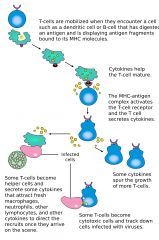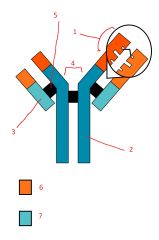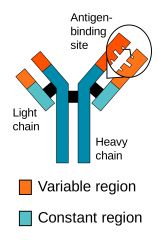![]()
![]()
![]()
Use LEFT and RIGHT arrow keys to navigate between flashcards;
Use UP and DOWN arrow keys to flip the card;
H to show hint;
A reads text to speech;
35 Cards in this Set
- Front
- Back
|
Describe the basis of 'innate immunity' |
Defences which are present before a pathognenic infection. These are non specific. |
|
|
What are the components of innate immunity? |
1. Anatomical barriers 2. Physiological barriers 3. Phagocytic / endocytic barriers 4. Complement 5. Interferons 6. Inflammatory barriers 7. Fever |
|
|
What are the anatomical barriers? |
1. Skin 2. Mucous membranes |
|
|
What are the physiological barriers? |
1. Temperature 2. pH (skin pH = 4) 3. Chemical mediators - sweat = salt and lysozyme |
|
|
What are the phagocytic /endocytic barriers? |
1. Monocytes 2. Neutrophils |
|
|
Describe the stages of neutrophilic attack. |
1. Chemotaxis towards pathogen 2. Adherence to 3. Ingestion 4. Digestion 5. Elimination |
|
|
What are the complement barriers? |
1. Opsonins 2. Chemotactic factors 3. trigger of inflammation & fever 4. Membrane attack complex -> lysis |
|
|
What is the role of interferons? |
Inhibit viral infection. |
|
|
What are the inflammatory barriers? |
1. Dilation and increased permeability of blood vessels through release of histamine, prostaglandin and leukotricenes 2. Migration of phagocytes 3. Tissue repair |
|
|
How is fever mediated? What does it enhance the effects of? |
1. Mediated by Interleukin 1 2. Enhances the effects of interferons and phagocytic activity |
|
|
What are the methods of pathogen recognition? |
1. Direct recognition 2. Opsonization |
|
|
How does the immune system directly recognise a pathogen? What receptors are involved in this recognition? |
Through receptors on the machrophage directly interacting with bacterium cell surface receptors. 1. Scavenger receptors 2. Leptin receptors |
|
|
What is the process of opsonization? |
Bacterial cells marked for destruction by the immune system |
|
|
What are the key principles of the adaptive immune system? |
1. Highly specific 2. Acquired 3. Diverse 4. Has a memory 5. Self / non self recognition |
|
|
What are the cells of the immune system? |
1. B Cells 2. T cells |
|
|
Where do B cells originate? Describe their structure. |
Originate in the bone marrow Antigen binding receptor bound by a membrane. |
|
|
How is a B cell activated? What processes occur upon its activation? |

1. Binding of complementary antigen 2. Rapid diffusion and differentiation into: i) Memory B cells ii) Plasma cells |
|
|
What is the role of plasma cells? |
Secrete antibodies. |
|
|
Where do T cells mature? |
In the thymus |
|
|
What is the unique T cell receptor? What does it recognise? |
1. Unique antigen binding molecule - T cell receptor - Recognises antigens bound to major histocompatibility complexes |
|
|
What is the role of major histocompatibility complexes? |
Bind peptide fragments from pathogens for displaying to T cells |
|
|
What are the types of T-Cell? |
1. T Helper cells 2. T cytotoxic (killer) |
|
|
What is the process of T cell activation and differentiation? |

1. mobilised by binding to MHC - antigen complex 2. MHC - antigen complex activates T cell to release cytokines 3. Cytokines mature T cells 4. Cytokines cause 3 divergin paths of differentiation i) some become T cells which secrete more cytokines ii) some become T helper cells which attract macrophages & neutrophils and direct them to pathogens iii) some become T cytotoxic cells which track down cells infected with viruses. |
|
|
What are the primary organs of the immune system? What is the general role of each? |
1. Thymus - Area of T cell maturation. 2. Bone marrow - Area of B cell maturation 3. Lymphatic system - links the primary and secondary lymphoid organs |
|
|
What are the secondary organs of the immune system? What is the general role of each? |
1. Lymph nodes - Sites where immune responses are mounted to antigens in lymph |
|
|
What are the different types of antibodies? |
1. M 2. G 3. A 4. D 5. E |
|

|

1. Antigen binding site 2. Heavy chain 3. Light chain 4. Hinge region 5. Disulfide bond 6. Variable region 7. Constant region |
|
|
What are the main categories of defence which an antibody mediates? |
1. Opsonization 2. Antibody dependent cell mediated cytotoxicity (ADCC) 3. Activation of complement 4. Precipitation (agglutination) 5. Neutralisation |
|
|
What is opsonization? |
Foreign particles targeted for destruction by phagocytes. |
|
|
What is Antibody dependent cell mediated cytotoxicity (ADCC) ? |
Antibody binds to virus infected target cells via Fc receptors of Natural killer cells which directs cytotoxic activity to apoptose the infected cell. |
|
|
What is an Fc receptor? |
An Fc receptor is a type of receptor found on the effector cells of the immune system such as T killer cells or natural killer cells. The Fc receptor will only bind to antibodies which are bound to a pathogen. |
|
|
What is the process of complement activation? |
IgM and IgG activate a series of glycoproteins - lysis of bacterial cell by perforation of membranes. |
|
|
What is the process of precipitation / agglutination? |
1. Hinders activity of pathogens 2. Increases chance of phagocytosis |
|
|
What is the process of neutralisation? |
1. Blocks toxin binding to cells via antigen bindin 2. Blocks bacterial attachment to cells via antigen binding |
|
|
Ultimately what does the extent pathogenicity of microbes depend on? |
Their ability to evade the immune response. |

